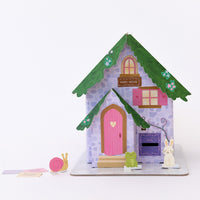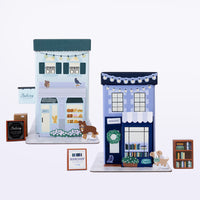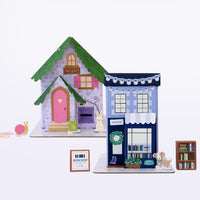
Books are the gateway to learning. They teach us about ourselves and the world around us. Representation in the media, through TV, movies, and books, starting in early childhood, is an essential element of framing a person's worldview. Children deserve exposure to various books where they can see themselves reflected and others represented meaningfully.
Windows and Mirrors
Books provide opportunities for children to see themselves and others represented. Reading a book, or having one read aloud to you, can be like looking into a mirror and seeing someone like you staring back at you, or like staring out a window and observing another person's experience, one you may not have the chance to interact with daily. Both of these elements are critical for children and their worldviews. Imagine a scenario where a child only has access to books that have a specific type of character, ones that look and act like themselves and their family. They would miss out on an extraordinary opportunity to learn about others and their stories and to have a complete picture of the diversity in our world.
While progress has been made in this area, our schools and local libraries are often not stocked with diverse books for readers to explore. For a variety of reasons, including underfunding, lack of knowledge, or bias, schools, libraries, and bookstores fall short when considering representation in the books they offer.
As caregivers, we can counteract this lack of diversity and provide the children in our lives with age-appropriate, rich literature. We at Make It Cute love the work OurShelves does in this area. They take the guesswork out of book selection for the littles in our lives by providing a curated bundle of high-quality, diverse books that feature traditionally underrepresented characters.
Integrating Reading Into Daily Life
Once the book selection is complete, we must integrate our diverse reads into our daily lives. There is a giant misconception surrounding reading. People believe reading must happen "properly," at bedtime, for example, or in a particular setting or time of day. The best thing about reading is that it can happen anywhere and anytime. Once you drop the notion that reading is only for specific times and places, it is easier to integrate reading into everyday life. Have time waiting at the bus stop or the car drop-off line in the morning? Bring a book. Waiting to check out at the grocery store line? Bring a book. Heading out for a meal at a restaurant? Bring a book. It will give you something to do while you wait and something to talk about when you finish. It will also build in reading as a constant part of each day, even when the time and place aren't always the same. You can carve out spaces to read anytime.
Another important lesson for kids is that reading is fundamental in everyday life. It is not just meant to be something you do inside of books, but that words and reading are incorporated into our daily life. Pointing out words and ways that you read throughout the day (a grocery list, a menu at a restaurant, street signs, game instructions, writing on t-shirts, names of TV shows, etc.) will show kids that reading goes beyond time sitting with an open book and into being a critical piece of everyday life.
Reinvigorating Reading Time
Experts regularly cite reading routines as positively impacting children, including in the realm of cognitive development, building language skills, and emotional bonding. Creating reading habits in early childhood leads to more preparedness for Kindergarten and better academic success later in life. This knowledge will likely motivate you, as the caregiver, to incorporate regular reading into your child's life. If you've already created a reading routine at home, that is excellent! If you're looking for ways to improve or revamp what you've already started, keep reading for ideas to reinvigorate reading time with your little ones.
Practical Tips for Caregivers
There are bound to be hiccups as you begin integrating or increasing the reading routines that happen in your everyday life, but there are ways to approach adding reading routines that will make the process easier.
#1 Start Small
Begin by adding 5-10 more minutes of reading into your day. It is up to you whether that is right before bedtime, waiting at school drop-off, or during dinner time. It doesn't have to look like the reading routines you've seen before, such as only reading during bedtime. Remain flexible and fit it in where it works for your family.
#2 Create a Cue
Use a phrase or quick song to indicate that reading time will begin. While we can't guarantee that reading will happen at the same time and in the same place each day, we can use a cue to help children understand that reading time is starting and get them in the right mindset. Creating a clear cue is a crucial piece of the habit-forming process and will help build your reading routine.
#3 Be Consistent
Stick with it and remain positive. Try a new routine for at least a week to work out the kinks and build it into your regular schedule. Once you've done it for a week, you can tweak it to make small changes to make it work better for your family.
Reading routines are an essential indicator of future success for children. With this knowledge, we know it is our responsibility, as caregivers, to incorporate more reading into our everyday lives for our children. With this lens, we can begin weaving reading routines into our children's lives with intentionality. We can cultivate bonding experiences with the children in our lives through modeling, consistency, and flexibility with everyday reading, knowing that this will be a cornerstone of their future success.
Reading a Rainbow
Just like eating a rainbow is crucial to our physical health, reading a rainbow or a diverse set of books is also important for our well-being. Each type of book provides us with new information or a view into another person's world, which provides a perspective we wouldn't have experienced otherwise. These variations make up a healthy worldview that expands our thinking beyond ourselves and our everyday experiences and helps us relate to others in a whole new way. It is never too early to begin reading to children. From birth, exposing children to books has many benefits, specifically in the realm of language development and future academic success, according to Psychology.com.
Benefits of Diverse Books
Reading diverse books offers numerous benefits for children, impacting their cognitive, social, and emotional development. Here are some key advantages:
- Promotes Empathy and Understanding:
- Exposure to Different Cultures and Perspectives: Diverse books allow children to see the world through the eyes of others, fostering empathy and understanding of different cultures, lifestyles, and experiences.
- Breaking Down Stereotypes: Reading about diverse characters and situations helps to challenge and dismantle stereotypes, encouraging children to appreciate individuality and the complexities of human experiences.
- Boosts Cognitive Skills:
- Critical Thinking: Encountering different viewpoints and experiences in literature encourages children to think critically about the world around them and question preconceived notions.
- Enhanced Vocabulary and Language Skills: Books that introduce children to various cultural contexts often include unique terms, phrases, and expressions, enriching their language and comprehension skills.
- Supports Social and Emotional Development:
- Self-Identity and Self-Esteem: Seeing characters who reflect their own backgrounds and experiences helps children feel seen and validated, boosting their self-esteem and sense of identity.
- Emotional Resilience: Stories depicting diverse challenges and triumphs can teach children how to cope with their difficulties, fostering emotional resilience and problem-solving skills.
- Encourages Inclusivity and Respect:
- Building Inclusive Attitudes: Early exposure to diversity through books can help children develop inclusive attitudes, making them more likely to respect and value differences as they grow older.
- Promoting Social Justice: Understanding social issues and injustices through literature can inspire children to advocate for equality and fairness in their communities.
- Fosters a Love of Reading:
- Relatability and Engagement: When children see themselves in stories or learn about fascinating new cultures and experiences, they are more likely to develop a love of reading. This engagement can lead to a lifelong passion for books and learning.
- Enhances Academic Achievement:
- Broader Knowledge Base: Reading various books exposes children to a wide range of information and ideas, contributing to a broader knowledge base and better academic performance.
- Improved School Readiness: Diverse books can improve school readiness for younger children by teaching them about the world in an engaging and age-appropriate way.
Overall, diverse books are crucial tools in shaping well-rounded, empathetic, and knowledgeable individuals. They enhance children's understanding of the world and contribute to a more inclusive and just society.
Make It Cute
At Make It Cute, we are proud to share diverse books with you because we know their value for all children. Our book recommendations, posted on our Instagram, are our way of sharing our family's favorites with the world. We know that many elements go into healthy childhood development, and just as a healthy dose of playtime is vital to childhood, so is literacy. Setting your child up for success involves both of these elements. Luckily, our playhouses are so versatile they can provide both an imaginary play space and a relaxing reading corner. Get the fun and family bonding started with our indoor playhouses today!
Connect With Us
Connect with Make It Cute on Instagram @makeitcutekids for some reading nook inspo and cool new reads your kids will love!









